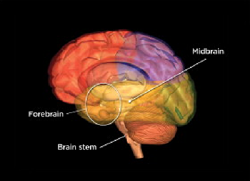Brain Stem Stroke

Brain stem strokes can have complex symptoms and can be hard to diagnose. A person may have vertigo, dizziness and severe imbalance without the hallmark of most strokes — weakness on one side of the body. Vertigo dizziness symptoms or imbalance usually occur together; dizziness alone is not a sign of stroke. A brain stem stroke can also cause double vision, slurred speech and decreased consciousness.
Only a half-inch in diameter, the brain stem controls all basic activities of the central nervous system: consciousness, blood pressure and breathing. All motor control for the body flows through it. Brain stem strokes can impair any or all these functions. More severe brain stem strokes can cause locked-in syndrome, a condition in which survivors can move only their eyes.
If a stroke in the brain stem results from a clot, the faster blood flow can be restored, the better the chances for recovery.
Like all strokes, brain stem strokes produce a wide spectrum of deficits and recovery. Whether a survivor has minor or severe deficits depends on the location of the stroke within the brain stem, the extent of injury and how quickly treatment is provided.
Risk factors for brain stem stroke are the same as for strokes in other areas of the brain: high blood pressure, diabetes, heart disease, atrial fibrillation and smoking. Similarly, brain stem strokes can be caused by a clot or a hemorrhage. Rare causes include injury to an artery due to sudden head or neck movements.
Recovery is possible. Because brain stem strokes don’t usually affect language ability, the patient is often able to participate more fully in rehabilitation. Double vision and vertigo usually resolve after several weeks of recovery in mild to moderate brain stem strokes.





